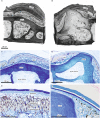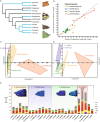Widespread bone-based fluorescence in chameleons
- PMID: 29335580
- PMCID: PMC5768862
- DOI: 10.1038/s41598-017-19070-7
Widespread bone-based fluorescence in chameleons
Abstract
Fluorescence is widespread in marine organisms but uncommon in terrestrial tetrapods. We here show that many chameleon species have bony tubercles protruding from the skull that are visible through their scales, and fluoresce under UV light. Tubercles arising from bones of the skull displace all dermal layers other than a thin, transparent layer of epidermis, creating a 'window' onto the bone. In the genus Calumma, the number of these tubercles is sexually dimorphic in most species, suggesting a signalling role, and also strongly reflects species groups, indicating systematic value of these features. Co-option of the known fluorescent properties of bone has never before been shown, yet it is widespread in the chameleons of Madagascar and some African chameleon genera, particularly in those genera living in forested, humid habitats known to have a higher relative component of ambient UV light. The fluorescence emits with a maximum at around 430 nm in blue colour which contrasts well to the green and brown background reflectance of forest habitats. This discovery opens new avenues in the study of signalling among chameleons and sexual selection factors driving ornamentation.
Conflict of interest statement
The authors declare that they have no competing interests.
Figures




References
Publication types
MeSH terms
LinkOut - more resources
Full Text Sources
Other Literature Sources

